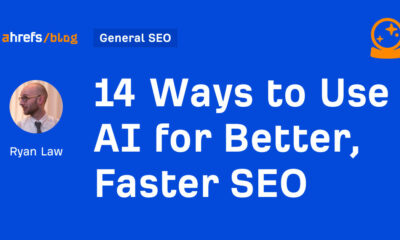PPC
8 Important B2B Marketing Trends for 2024

For us B2B marketers, it’s time to reassess everything. Our tech tools are light years from where they were a few years ago. Old strategies aren’t producing like they used to. And customers search for solutions in places we never thought to go. There’s a lot of promise, but we’ll need to know which B2B marketing trends to keep a keen eye on for 2024.
We’ve listened to the marketing podcasts, read the data, and followed the leaders on LinkedIn. Eight trends in B2B marketing percolated through it all. We’ve listed them here and added tactics you can use to get ahead of the curve this year.
Table of contents
The 8 biggest B2B marketing trends for 2024
Pin these trends for your 2024 B2B marketing strategy so it’s built to generate new leads all year long.
1. Ethical data collection becomes a necessary skill for B2B marketers
The increased focus on data privacy will impact marketers’ ability to measure marketing and collect data from users. In 2024, you’ll need to be more creative and transparent to learn about your customers.
The biggest driver of this shift is the long-awaited end of third-party cookies by Q3 of 2024. This means first-party data will do a lot of the heavy lifting in our quarterly reports.
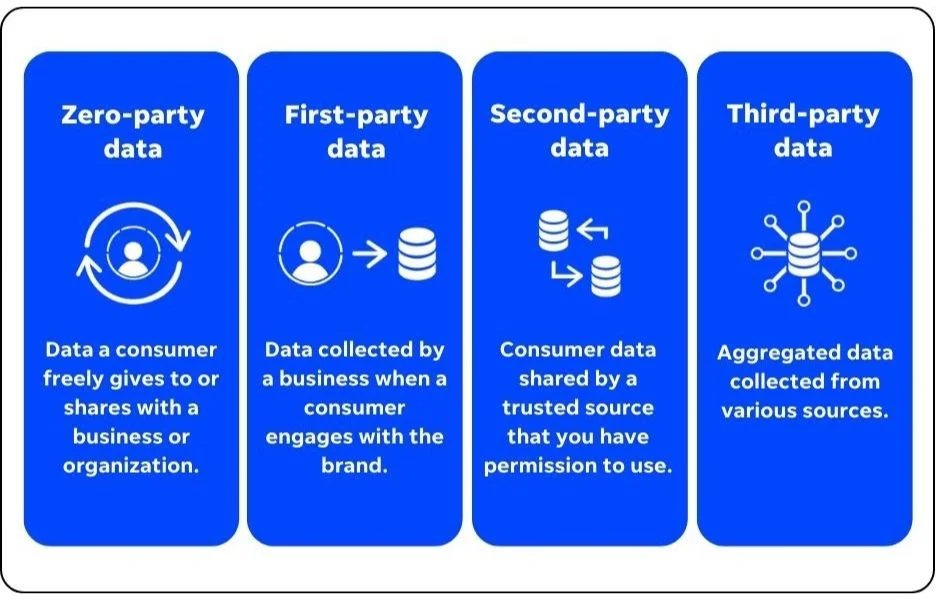
First-party data can be highly accurate, but it requires a customer to opt-in or engage with your website so it’s harder to collect at scale. In 2024, B2B marketers will need to become well-versed in ethical data collection strategies that don’t rely on third-party cookies.
Here are a few ways you can collect first-party data and set up your marketing for a cookie-less future.
Build out your email list
Your email list is the gold standard of first-party, ethically sourced customer data. Not only do you get critical engagement data, but you also get an owned channel you can use for other data collection tactics.
The key to growing your email list is offering something of value in exchange for a new subscriber’s email address. A few ideas to consider include:
- Creating a newsletter
- Offering a discount to new subscribers
- Using your best content as a lead magnet
Run a contest
Contests are a cost-effective way to gather first-party data. With the cost of one prize, you ethically collect data from thousands of current or potential customers.
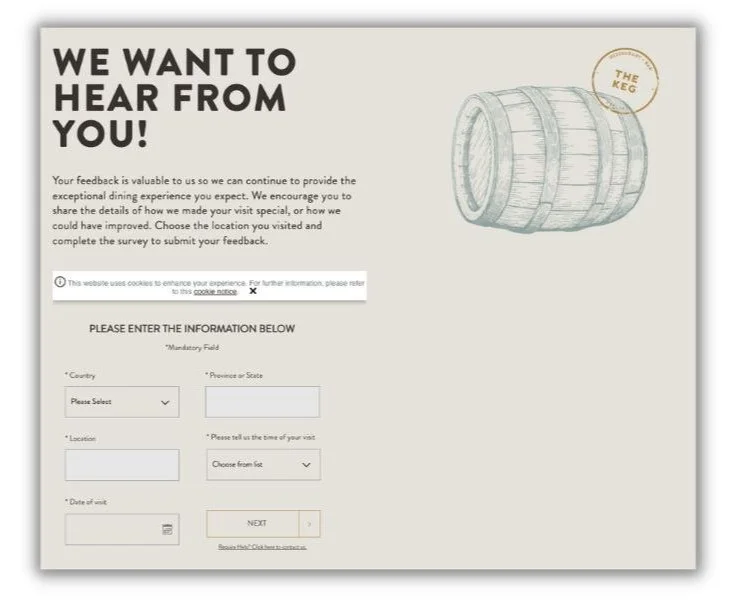

Contests are a versatile data-collection tool. You can use them to encourage product feedback, gather demographic information about your customers, or understand how people use your product.
Choose the right data
Be mindful of your goals before launching a first-party data collection initiative. If you’re generating awareness about a new product, you’ll be interested in what types of educational content people read or how they’re currently solving a problem. But if you’re learning about people lower in the marketing funnel, you may focus on which product pages people click on. Make sure you know what questions you want to answer before collecting the data.
2. AI will make B2B digital marketing more efficient and effective
New AI-powered tools from advertising platforms make ad creation easier while giving you new ways to target more people.
In 2023, Google announced several new AI features for Google Ads. One of the most interesting is semi-autonomous ad asset creation. With a few prompts, Google’s Asset Creation for Performance Max will create a custom image, video, and text for your campaign.
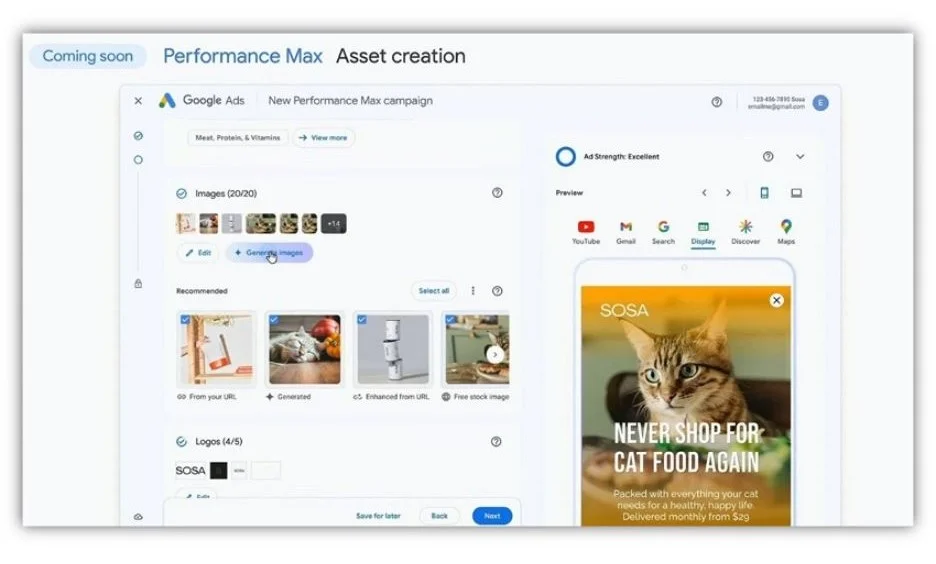

TikTok’s new AI-powered virtual assistant helps marketers create better ads for the social media platform. TikTok Creative Assistant works like a chatbot. You can prompt it for post ideas and ad scripts specific to your brand, or ask it to show you popular TikToks from your industry.
On Facebook, AI underpins Advantage+—an advanced way to continuously improve ad targeting. The platform uses machine learning to automatically adjust ad targeting based on pixel data, conversion history, and the audience that engages with your content.
As each marketing platform vies for your ad spend, you can expect them to bake in more AI features in 2024.
Updates are coming fast and furious. Here’s how you can stay on top of them.
Mark your calendar for Google Marketing Live
Google announces its key updates every year at its Google Marketing Live event. Look out for this year’s version. And in the meantime, peruse the content from previous years.
Review announcement boards
Each platform collates a collection of announcements in a central location. Here are a few of the most important places to look for announcements:
3. B2B marketing podcasts get a new life
Most B2B podcasts seem to come and go in the blink of an eye. Mainly that’s because it’s really hard to build a large enough audience to justify the effort. But in 2024, expect to see a new class of podcasts pop up, and their primary purpose won’t be to attract listeners.
A few forward-thinking B2B marketers are launching podcasts specifically for the wellspring of ideas and industry insights they produce.
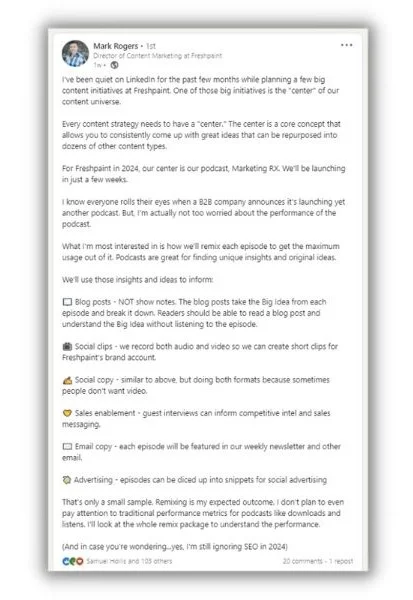

Freshpaint’s new podcast is more about generating ideas than new followers.
It’s a smart play. Especially as Google’s core updates shuffle SERPs faster than a Las Vegas blackjack dealer. The quotes and first-hand experience from a single episode can be repurposed into a dozen different assets and distributed on multiple platforms.
This is uncharted territory for many marketers. Here are a few ideas to help you tap into podcasts for ideation.
Let distribution guide creation
Long before you pick a catchy opening track, lay out a strategy for distributing the content that comes from your podcast. Where and how you’ll repurpose your show should guide the types of guests you interview, your format, and the questions you answer.
Get creative with distribution channels
Instagram Reels is a natural place to share a snippet of video from your podcast. But don’t forget placing a piece of the transcript in emails or adding value to an ebook with quotes from the show.
4. B2B marketers will benefit from more video content in 2024
We’ve known about the power of video in marketing for a while now. On average, video marketing generates more leads than other mediums, it increases advertising ROI, and most people say they prefer watching videos to learn about new products.
In 2024, we’ll see B2B marketers making use of video in more creative ways. For example, short clips posted natively on LinkedIn can be a funnel to get new subscribers for your YouTube channel.
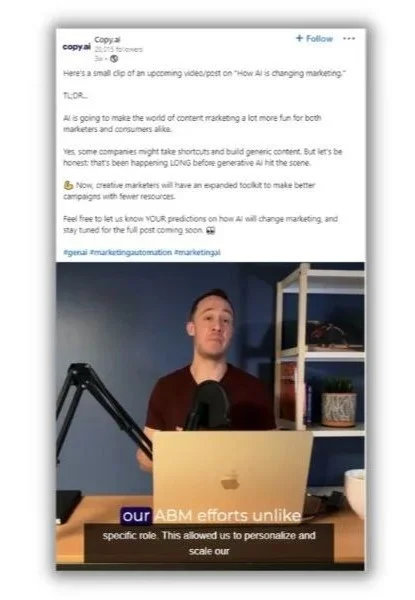

Copy.ai uses short clips on LinkedIn to promote their long-form videos
Expect to see a lot more faces and fewer impersonal product demos in videos, too. The drive for authenticity and transparency is a big content marketing trend this year.
For beginners, video feels daunting. But with a few tips like these, you’ll post video content that generates more engagement than a text-only post ever could.
Don’t worry about high production quality
You don’t need a crew, expensive equipment, and a dozen hours to edit each video. A simple, authentic clip of you making a complicated topic understandable will get plenty of engagement. Your smartphone and a cheap ring light is all you need.
Repurpose your video content
Even simple videos take a bit of time to write and record. Make the most of them by slicing them up for multiple channels. Create an attention-grabbing thumbnail and post it to YouTube. Embed them in your blog articles. Share a snippet as an Instagram Story.
5. TikTok matures into a B2B marketing channel
Elder Gen Z’s are aging into decision-making roles. To reach this budding band of B2B buyers, marketers will turn their talents to TikTok in 2024.
The youngest adults have already made TikTok a search engine—57% of Gen Zs say they prefer the short-form video platform over Google for finding answers and products. So when they’re researching vendors for work or want to learn something about their job, it’s safe to assume they’ll head to TikTok to do it.
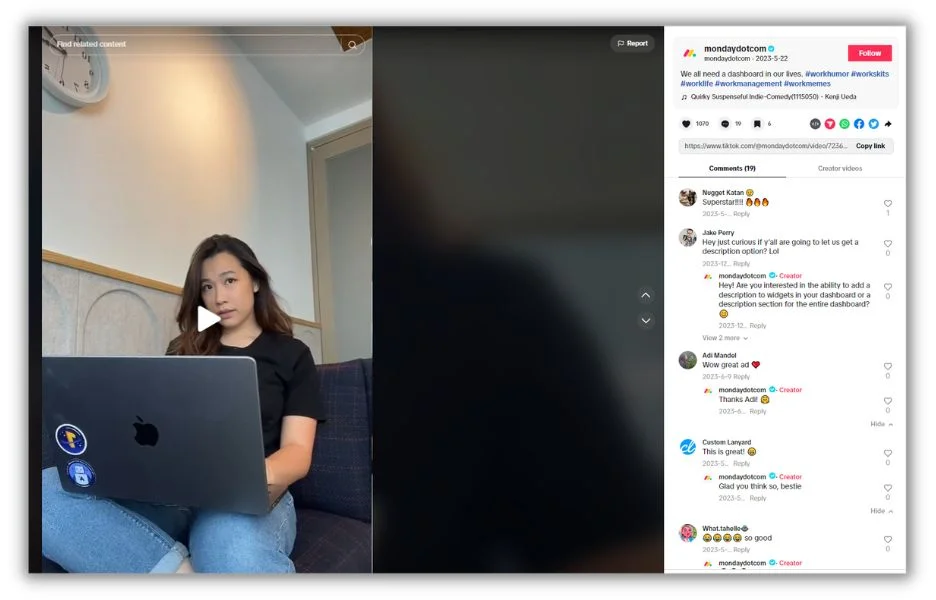

Monday.com’s TikToks are fun, educational, and relatable.
As Gen Z’s influence in the workplace grows, you can be sure B2B marketers will follow them to their favorite places online.
TikTok is full of creators who know how to work the algorithm and engage viewers there. You’ll need to take a different, more creative approach. These tips will help.
Try TikTok ads
TikTok ads are a great way to get in front of your target audience even before you’ve built a large organic audience. TikTok’s marketing platform has some pretty impressive ad features like custom audiences and the aforementioned AI-enabled ad assistant.
Don’t forget your call to action
Your TikToks are the neon sign that gets people’s attention on a busy road. You still need a strong call to action that steers them to your website. A great TikTok CTA:
- Starts with a strong verb like join, buy, shop
- Has two or three words max
- Is placed prominently so it’s not buried in a long caption
6. B2B communities will help overcome new marketing challenges
If you’re connected to a lot of B2B marketers on LinkedIn you’re bound to see the word “community” tucked into some of their titles. That’s a trend we expect to see expand in 2024.
Brand communities have been hugely successful in B2C. Sephora’s Beauty Insider Community has over 5 million members generating UGC content, acting as product experts, and evangelizing the brand.
B2B marketers are thinking about how brand communities can solve some of their new challenges. When done right, a B2B community can:
- Provide an endless supply of ethically acquired first-party data
- Be an authentic and trustworthy source of information about a brand and its products
- Crowdsource user support for products, reducing the stress on internal customer support reps
- Accelerate adoption of new features
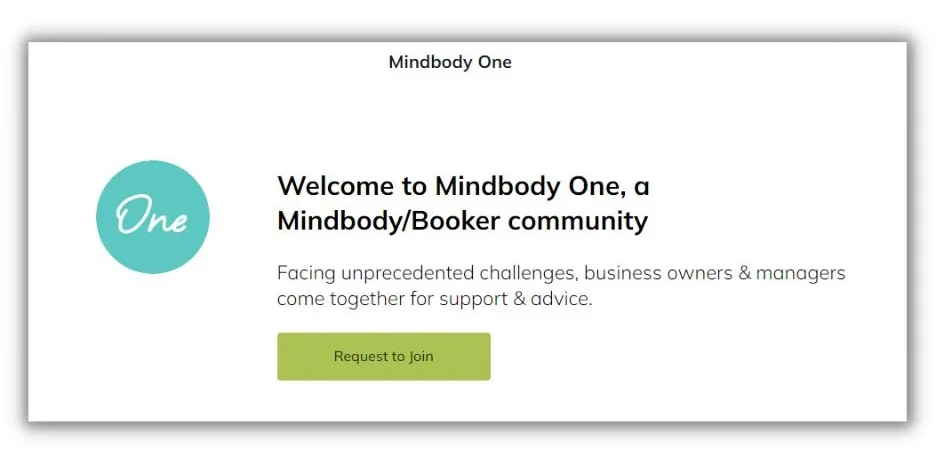

Mindbody One is a community of business owners and managers in the wellness industry created by scheduling and management software provider Mindbody.
Communities can look a little different in the B2B space. Here are a few tips that’ll help you create a community that serves your unique business.
Consider a range of platforms
You can structure your online community on a platform you own or on a third-party platform. An owned platform—like something housed on your website—can be a little trickier to get off the ground, but you’ll have more control over it. You can ramp up a community as a social media group or on Slack faster, but you’re beholden to their rules and capabilities. Decide if flexibility or ease is your priority before launching.
Avoid the temptation to be overly promotional
When you have access to a group of loyal customers, it’s easy to get carried away with sending sales promotions. An occasional offer (especially if it’s exclusive to the group) is OK, but spend more time fostering conversations and support between members.
Stay engaged
People like to be heard by the brands they support. So stay active in your community. Ask for opinions, spotlight community members, and hold Q&A sessions to keep the conversation flowing.
7. We’ll see an influencer influx in B2B marketing
In 2024, B2B marketers will be looking for ways to create authentic engagements that feature real people offering relatable insights and solutions. There’s already a track record of influencer marketing doing that for B2C businesses. This year we’ll see many more B2B marketers invest in an influencer strategy.


GE set a group of Instagram photographers loose in one of their jet engine testing facilities and gained a ton of new content and awareness for the B2B side of their business.
Many of these new B2B brand advocates will come from within the businesses’ ranks. These internal influencers will share the brand’s content, announce product launches, and help recruit new team members.


IBM set up an Instagram account where its employees share what it’s like to work at the electronics giant.
Like every marketing strategy, how you do it will dictate how well it works. Use these tips to develop a high-performing B2B influencer marketing strategy.
Consider a micro-influencer
Your best influencer isn’t necessarily the one with the biggest social media following. In fact, someone who has high engagement with a thousand people in your target market could deliver a huge return. Remember that your influencer’s followers also have a network, so you could gain visibility well beyond the initial audience.
Reward your internal influencers
If social media isn’t a part of someone’s regular job duties, make sure to offer them something in exchange for their brand evangelism. They’re not only creating posts, but they’re also giving you access to their personal social media accounts—which they’ve spent time developing.
Set clear goals from the start
You’ll need to justify your influencer investment. You should have a clear idea of what a good payback looks like for your company before launching the strategy. Get buy-in from senior management on your metrics so there’s no question that the program is working.
Original data will be key to working with, and besting, AI
Prompt-and-post AI content can steal your search traffic in the short term. Original data and experiences will not only retake the SERPs, but it’ll also help you get clicks outside of search engines.
Some shady AI content factories got a lot of early traffic pushing hundreds of posts out quickly. Google is starting to take action, dropping those robo posts from the ranks and throttling the websites’ traffic.


In 2024, expect to see more marketers creating content based on original data and first-hand experiences that no one else has as an AI-proof solution. Customer stories, “building in public” posts, industry surveys, and deep dives into internal data are examples.
This type of content meets Goggles E-E-A-T requirement, so it should be more competitive on SERPs.
But content based on new information you’ve collected has another superpower. It’s a backlink magnet that other writers will link to and share with their networks.


Our Facebook ads benchmark report generates lots of new backlinks for us and is regularly referenced in newsletter roundups.
The marketers who lead with first-hand experience and data will see the biggest gains in 2024.
Businesses of any size can use original data to make their marketing better. These tips are useful no matter how big your marketing is.
Conduct customer interviews
Pretty much every business has customers and they’re all a great source of stories and insights about your industry. You can talk to them about how they use your product. Or go up-funnel and ask them to describe a common industry challenge they had and how they overcame it. The idea is to use their original experiences to educate others in their position.
Pull internal data
What data do you have about your customers? If it’s useful to others and you can make it anonymous, build a blog post, report, or video around it. The data will be easier to gather if you sell some type of software. But say you sell a range of power tools to professional landscapers. What types of tools are they buying this year? What time of year do they start buying? These insights could be helpful to resellers or landscapers looking to make a purchase.
Share your own experience
There’s not a business on earth that doesn’t have a “how we got here” story. And it’ll be interesting to any other business that’s trying to grow. Even better, if you made a bad choice along the way and learned something from it, write about it. People will flock to that content.
Have your best year ever with these B2B marketing trends
2024 could either be the best of times or the worst of times for B2B marketers. Those who stick to the old strategies will have a rough go of it. But for the marketers that intentionally experiment with new tech and adapt to changing customer preferences, 2024 will be an exciting year.
PPC
Google Ads Releases New Search Partner Insights & Controls Following Advertiser Concerns

One of Google Ad’s top benefits is its massive reach. Advertisers can easily reach billions of people across the greater web through Google search, Shopping, Maps, Gmail, YouTube, Discover, and more than 2 million different partner websites and apps. Google makes it easy for advertisers to reach all of these constantly updating placements across the web, too. Some of Google’s campaign types–such as Performance Max, App, and Smart campaigns–even automatically target all of these available placements to further simplify reaching this massive audience for advertisers.
However, seasoned advertisers know that not all placements are equally valuable. In fact, your brand’s ad next to the wrong content can upset your customers, damage your brand, and work against your goals. It’s crucial to monitor where your ads appear online to prevent these missteps, but for years, advertisers couldn’t view or control some of their ad placements on Google, specifically in their search partner network.
However, after some recent vocal concerns from brands, Google has responded and released a new tool for some advertisers to review their ad placements across the search partner network and exclude placements that may be inappropriate.
Contents
What is the Google Ads Search Partner network?
Believe it or not, Google isn’t the only search engine across the web! There are hundreds of smaller search engines and millions of websites with search bars–and many of them serve similar PPC ads within their search results. However, most of these smaller sites don’t build their own advertising platforms, such as Google Ads or Microsoft Advertising. Instead, they partner with Google (or Microsoft) to help advertisers connect with searches on their sites. These secondary search engines across the web make up the Search Partner network and collectively make up a decent share of search traffic for many industries.
🚨 Ready to learn how to maximize your campaign success across networks? Start with our free Google Ads Grader!
Google’s Search Network is comprised of two main components:
- Google search sites, which include Google Search, Google Shopping, Google Images, and Google Maps.
- Search Partner network includes YouTube search, smaller partner engines, and sites that host a search bar powered by Google. A surprising number of local and specialty websites are part of the Search Network–including some recognizable tertiary search engines like Ask.com.
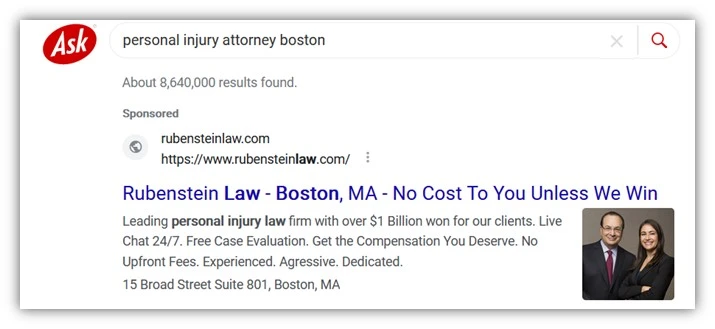
In Google Ads, advertisers can easily view their search campaigns’ results and segment their performance between Google search and the Search Partner network. Within search campaigns, advertisers can easily opt out of the Search Network at any time within their campaigns’ settings.


However, Google’s Performance Max campaigns don’t offer that visibility or flexibility to advertisers. Google’s Performance Max (and other fully automated campaign types) dynamically places your ads across the entire Google network (Google search, search partners, display, YouTube, video, discover, and Gmail) to dynamically use AI to maximize your campaign’s results.
The problems with Google’s Search Partner Network
Google’s Search Partner network’s additional reach is generally positive for advertisers–but that reach comes at additional costs and concerns. Even if most search partners on the network are from reputable, high-quality sites, the vast internet unfortunately hosts many low-quality sites and bad agents.
Google has never previously shared a list or directory of its ever-changing search partners. And unlike placements across the Google Display Network, advertisers haven’t been able to review where their ads appeared on the Search Network. Search advertisers had the choice to buy ads on the entire Search Partner network–or opt out entirely. Advertisers using Performance Max campaigns were automatically included across the entire Google network, including Search Partners.
Over the years, advertisers have become increasingly worried and vocal about the kinds of content their ads appeared alongside, and many advertisers have serious concerns about their brand image across the web.
Recently, Adalytics published a study revealing some concerning placements across the search partner network and discovered that several large companies, agencies, and government agencies were allegedly paying to show ads across some very questionable sites. Some of the examples from their study include pornographic content, pirated content, and sites that may be subject to international sanctions.
Google largely refuted the claims from Adalytics and assured advertisers that ad revenue wasn’t being shared with sanctioned entities. They further asserted that Adalytics claims were exaggerated and that such sites “represent a minuscule amount of [Google’s] Search Partner network.”
Shortly afterward, Google announced it would temporarily allow advertisers to opt out of the Search Partner network in Performance Max and App campaigns until March 1. Advertisers would have to contact Google directly to opt out of Search Partners in these campaigns.
Google’s new Performance Max campaign placement report
Addressing advertiser’s growing concerns, Google announced that it would begin to share more insights into where advertisers’ ads appeared across the web, including on the Search Partner network. Starting on March 4, advertisers can review how frequently their ads appeared across individual placements within their Performance Max and App campaigns.
The report is now available to all advertisers with active Performance Max and App campaigns. However, the reporting is slightly hidden from how advertisers generally review their search queries or other ad placements. Instead, advertisers can find these two new reports within the “report editor” section of the Google Ads dashboard.


The new Performance Max campaign placement report shows where and how often your Performance Max ads appeared on different placements from the web. Unfortunately, the report only shows the ad impressions from your Performance Max campaigns–other performance metrics, such as clicks, costs, and conversions, are unavailable.
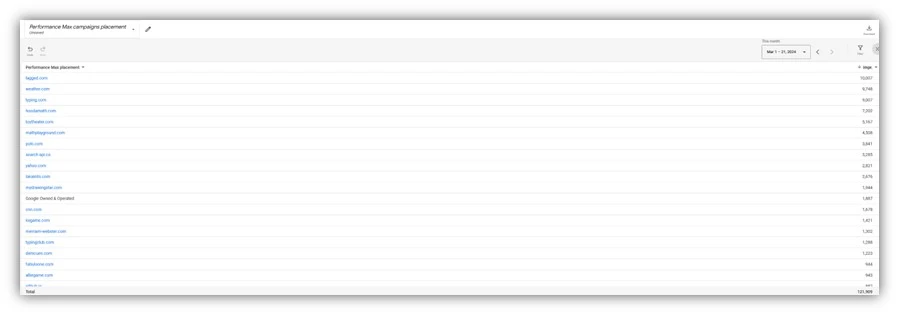

This reporting is only available for Performance Max and App campaigns. Traditional search and shopping campaigns still do not have any reporting available for individual placements across the search partner network.
🛠️ Set your Google Ads campaigns up for success with our free guide to the perfect Google Ads account structure!
How to opt out of Google search partner placements
Starting in March, Google will also allow advertisers to exclude individual Search Partner placements from showing ads for any campaigns in their account, including Performance Max. The placement exclusion can only be added at the account level–unlike many other placement exclusions, which are available at the campaign or ad group level.
To exclude a placement from showing your ads, you will need to create a placement exclusion list and apply it to your account. The Placement exclusion lists are kept under the “Tools and Settings” menu in Google Ads, under the “Shared Library.”
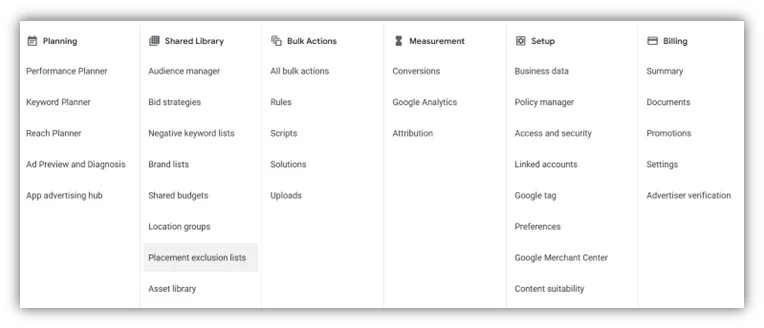

Once you create a new exclusion list, it will automatically be added to all of your campaigns in that account. New placement exclusions may take up to 12 hours to go into effect.
Take control over where your brand shows online
Google’s newest placement reports and exclusion options are designed to give advertisers more visibility into where their ads appear across the web and more control over their brand online. How much you decide to use these controls is up to you, but it’s always a best practice to review your placements and add new exclusions regularly.
Want more like this? How to Use Google’s New Brand Restrictions to Gain Back Control of Your Spend
PPC
5 Campaign Red Flags And Why They Matter

As PPC experts, we rarely have the luxury of harnessing 100% of our efforts and energy into a single account. When we do, it’s usually substantial, with multiple markets, products, and budgets to consider.
With a plethora of metrics to learn and utilize, optimizing our campaigns can feel overwhelming. Over the years, I’ve narrowed the optimization tasks down to focus on five key metrics and red flags. This will allow you to execute fast and effective boosts to campaign performance and efficiencies.
Here are 5 red flags to look out for on your PPC campaigns and, crucially, how to fix them.
1. A Weak Clickthrough Rate
We all know the importance of CTR (click-through rate) as a metric. It serves as a strong indicator of relevance between our keywords, our ads, and the user’s search terms. While the go-to benchmark used to be 2-3%, the introduction of automated bidding strategies and RSAs has moved this closer to 5-6% in most industries.
A CTR below this level raises considerable red flags. Not only does it indicate weak ad group relevancy, but it’s inefficient; the ‘Expected CTR’ of your ad has an effect on your ad rank, and bid, and will see you falling short at auction time.
Here are two simple, yet effective, fixes for a weak CTR:
Take your Assets Reports – a breakdown of the effectiveness of each headline and description – and start by swapping those ranked ‘Poor’ or ‘Average’ to new alternatives on your ads.
The second simple step is to review your ad groups. Over time, your ad groups and your keyword list are both likely to have expanded. Are there any opportunities to separate top-performing keywords from the rest? Do your keywords fit one neat theme, or are multiple themes creeping in? If so, separate them and tailor each ad’s copy to the new themes.
2. Missing or incomplete campaign settings
Back to basics. As someone who has audited 100s of accounts, time and time again I see the same handful of issues. By now, we’re all surely aware of the sneaky default location setting of ‘People interested in your targeted locations’ over ‘People in your targeted locations’. (If not, double-check your campaigns to ensure they’re serving where your target audience is!). There are, however, a few more settings worth checking on, and language settings are one of these.
On Google, language targeting matches queries “where the keywords match and Google believe that the user understands at least one targeted language”. On Microsoft Ads, the language campaign setting “determines the language that you will use when you write your ads and should be the language of your customers”.
Whether or not your brand has a global reach, your ad copy within each campaign is unlikely to be in all languages (often the default setting). When serving an international audience, best practice is to create unique campaigns and ad copy native to the respective local languages. Regional nuance is critical too.
Check your Campaign Settings to ensure that the language of your ad copy matches the audience(s) you’re asking your PPC platform to reach.
3. A lack of exclusions
If you’re running your accounts at peak efficiency, you should have plenty of exclusions in place. With the push towards upgrading your keywords to broad match, performance max black boxes, and a substantial rise in automation techniques, we PPC heroes need to be more on top of exclusions than previously.
Whether you’re running search, performance max, video, or display campaigns, exclusions are likely to apply to your campaigns.
Such exclusions include:
- Negative keywords
- Audience exclusions
- Content suitability, placement, or topic exclusions
- Brand exclusion lists
- Location or country-level exclusions.
If you don’t currently have exclusions applied to your campaigns, that could mean inefficient campaigns: targeting the wrong keywords, showing ads to current customer lists, on irrelevant or harmful content, on competitor content, or even in the wrong country entirely!
As a simple first step, begin by applying negative keywords to your account, campaigns, and/or ad groups and review your basic audience targeting options. If you can exclude current customers, reduce your demographic targeting from 18-65+, and double-check your campaign targeting and exclusion settings, that’s a great start.
4. Sub-par quality scores
One of the easiest ways to create inefficiencies is by failing to monitor quality scores. According to Google Ads, quality score is “a diagnostic tool meant to give you a sense of how well your ad quality compares to other advertisers”. This score is from 1-10, (1 being poor, 10 being excellent), is available at the keyword level, and is a product of the following three factors ranked from “below average” to “average” and “above average”.
- Expected CTR: Based on historical data, how likely is it that your ad will be clicked?
- Ad rank: How closely does your ad match the user’s search query and the intent behind it?
- Landing page experience: How useful is your landing page? Does it answer or support the user’s search query?
Luckily for those of us who struggle with math, the platforms calculate these for us based on the last 90 days of auction insights. In a perfect world, we’d aim for a quality score of 10 – although that may not always be possible. However, 7 or above is indicative of a ‘good’ quality score, with 3 or below being poor.
As with other items mentioned in this list, weak quality scores contribute to inefficient campaigns. To address this, work on optimizing each of the above three factors, starting with any that are ranked “below average”. Remember: the ultimate goal is to ensure that your keywords, ad copy, and landing pages are consistent in content.
5. No conversion data
And finally, one of the biggest red flags is a lack of conversion data. Generating zero conversions is one thing – and may be a red flag, but having no conversion data at all is concerning.
Today, PPC platforms are much stronger – particularly on brand-new accounts – on encouraging conversion setups before creating or publishing a campaign. However, there are plenty of legacy accounts with old, incomplete, or out-of-date conversion tracking, likely leading to millions of dollars in wasted spend annually. If you’ve been putting off the dreaded conversion tracking setup process, don’t delay further.
The final tip here is to ensure your conversion tracking is up to today’s standards. While conversion tracking for the end-goal of your campaigns is undeniably important, you’ll also want to track ‘lighter’ conversion events to give your PPC platform all the signals it needs to generate conversions – particularly when using smart bidding strategies.
If you’re using Maximize Conversions, Target CPA, Target ROAS, or Maximize Conversion Value smart bidding strategies and you have multiple conversion methods tracked (such as app downloads, phone calls, lead form fills, and product page views), ensure that each conversion is set up as a ‘Primary’ or ‘Secondary’ conversion goal respective to how important it is. Multiple primary conversion goals will make it difficult to optimize your campaigns.
Summary
Whether you’re brand new to PPC or have decades of experience, frequent platform changes often mean adapting what you thought you already knew! The five tips above should give you a great starting point for optimizing, improving, and boosting the efficiency and effectiveness of your accounts. Good luck!
PPC
86 Summer-Ready June Content Ideas

June marks the official start of summer, opening up many creative ways to connect with your audience. Throw in June’s holidays, summer solstice, and a bounty of food-themed days of appreciation (we’re looking at you, National Doughnut Day), and your June content calendar runneth over.
With all that fun in mind, we’ve gathered dozens of creative June content ideas. From entertaining videos to educational emails, you’ll find plenty of inspiration to fill this month’s content calendar.
Contents
💡 Want an entire year’s worth of marketing ideas? Download The Mega Must-Have Marketing Calendar.
June holiday content ideas
Although this month does not have any tentpole holidays like Thanksgiving or Christmas, there are several June holidays worth celebrating.
Father’s Day (June 16)
Great parents should be celebrated every day, but let’s face it, they’re often in the background doing the hard work most people don’t see. That’s why we celebrate Mother’s Day in May and Father’s Day in June, so these often unsung heroes get a little of the recognition they deserve.
If you want to get a gift for a dad with no strings attached, buy them a broken guitar (cue the groan). But seriously (sort of), Fire Department Coffee found a fun way to celebrate Father’s Day with an Instagram Reel full of dad jokes.
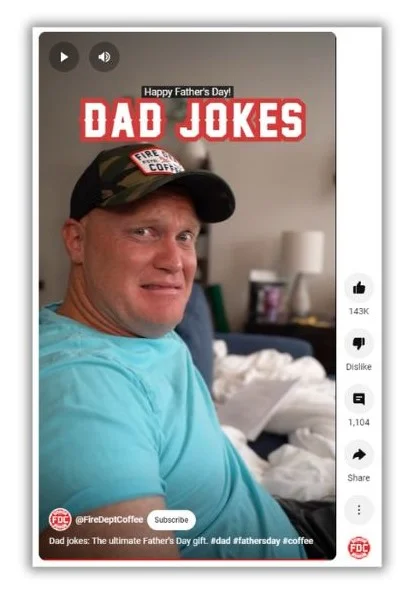
This is a low-lift way to have a little fun with your audience while keeping in the spirit of Dad’s big day.
Here’s another thing to be aware of. Father’s Day can be a difficult time for some people. If you’re running a Father’s Day email campaign, give your subscribers a way to opt out.
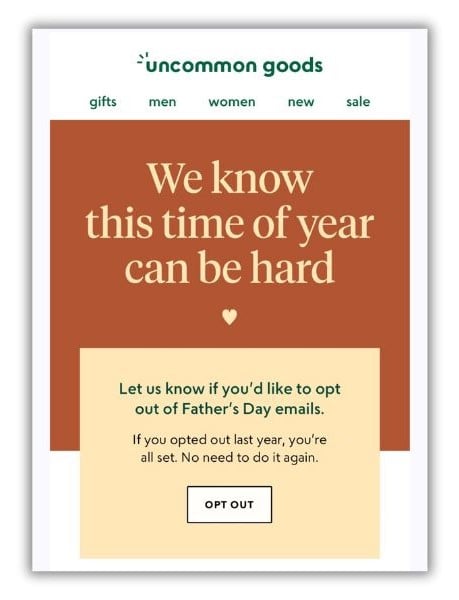

here are several other June content ideas geared toward dads and the people who care about them:
- Have a dad joke competition on social media.
- Get dads to comment describing their favorite way to spend Father’s Day.
- Write a blog post listing local Father’s Day discounts and events.
- Share a heartfelt shout-out to everyone who has lost their father, stepped in as a father figure, hopeful dads facing fertility issues, and fathers who have lost a child.
👋 Email is one of the best marketing channels available. Use The Complete Email Marketing Toolkit (Free Email Templates, Subject Lines, & Tips) to make the most of it.
Juneteenth (June 19)
On June 19, 1865—more than two years after President Lincoln signed the Emancipation Proclamation—Union troops arrived in Galveston Bay, Texas, the final holdout for the practice of slavery in the US. On that day, 250,000 enslaved Africans were finally granted their freedom. We now commemorate the history of that day as Juneteenth, often considered the second American Independence Day.
Juneteenth festivals are increasingly popular, with events popping up in big cities and small towns alike. The Brooklyn Mavens help their followers find the events by posting a video on Instagram with a roundup of what’s happening Juneteenth weekend.
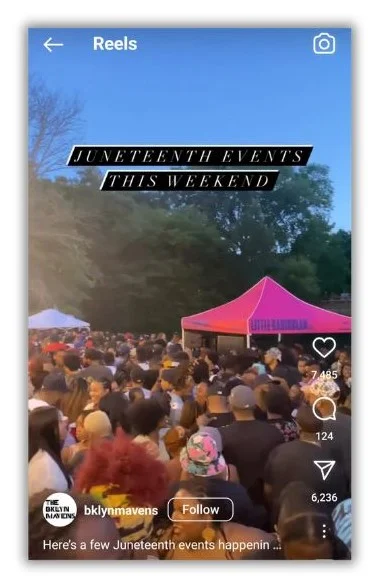

You can do the same on social media posts, blog posts, or even by email. But there are plenty of other ways to share in this important day. Here are a few ideas to get you started:
- Post powerful quotes from African American leaders.
- Write an article explaining the history of Juneteenth, covering what happened before and June 19th.
- Create a cooking video featuring Juneteenth-inspired recipes.
- Curate a list of books from Black authors or highlight the works of Black visual artists.
- Share a list of Black-owned businesses in your area.
Pre-Independence Day
For many people, the 4th of July is a big event that requires plenty of planning. That means you should share at least some of your Independence Day content ahead of time in late June.
ExtraSpace Storage shows us how it’s done with an extensive blog post full of ideas for a sparkling Fourth of July party.
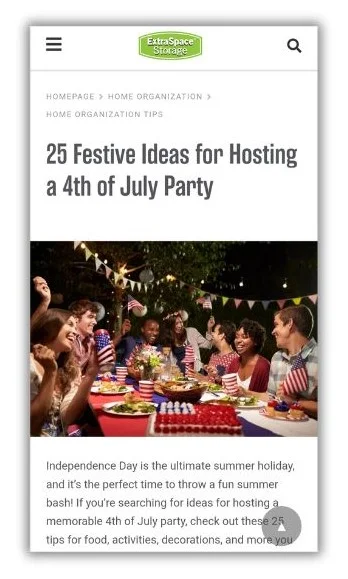

You can use the same strategy and create a big roundup of party planning ideas or go deep on one or two parts of planning a celebration, like these:
- Post a patriotic music playlist.
- Video a video showing how to clean and prep a gas grill.
- Make a shopping list of essentials for the perfect Independence Day party.
- Note local fireworks regulations and safety tips, plus mention that June is National PTSD Awareness Month as a way to remind people to be considerate with their fireworks displays.
June food content ideas
Sometimes, the fastest way to your followers’ hearts is through their stomachs. When it comes to planning your June marketing, don’t sleep on June’s variety of victual delights.
National Doughnut Day (June 7)
If you need to fill a hole in your June marketing calendar, celebrate one of the most beloved foods on the planet: the mighty doughnut! Just about anything you publish will garner good feelings (and maybe make your competition a little jelly).
The icing on top is that your brand doesn’t need to be a purveyor of cylindrical breakfast snacks at all. Take a look at this pastry-perfect post from Famer’s Almanac.


What’s brilliant about this tactic is the social media post directs viewers to a recipe on the Almanac’s website, offering a surgery slide into the business’s marketing funnel. Want to cash in on this confectionary? Try these Doughnut Day ideas for yourself:
- Get followers to vote on a March Madness-like bracket of the best doughnut toppings and fillings.
- Let people know where they can get discounts and specialty doughnuts around town.
- Create a slideshow of the most unusual, real-life doughnut recipes (like the hibiscus doughnut or the infamous cayenne pepper-topped Ring of Fire).
- Just share a picture of your staff enjoying their favorite doughnut.
National Corn on the Cob Day (June 11)
It may not have the draw of doughnuts, but no food signifies the start of summer like a fresh ear of corn on the cob. National Corn on the Cob Day, celebrated on June 11, is the perfect opportunity to engage anyone stalking your marketing channels.
This diabetes wellness account on Facebook has a cool take on hot corn. It shows you how to prepare corn on the cob without the extra calories and salt that come with traditional methods.


There are dozens of variations on the recipe that you can use. But don’t stop there. Mix in some more of these corny content ideas:
- Take a poll on Instagram asking how people eat their corn (with two-pronged cob holders, using the husk like a handle, or grabbing the ear with reckless abandon).
- Post some corn facts, like alternative uses for corn, the fact that corn cobs always have an even number of rows, or that the tallest recorded corn stalk was 48 feet high.
- Share a healthy dose of corny jokes (Know what happened to the corn that was fed up with his job? He went into a completely different field).
More food June content ideas
We told you June was full of food-themed content opportunities. Here’s the proof.
- National Candy Month
- National Fresh Fruit and Vegetables Month
- National Rocky Road Day (June 2)
- National Egg Day (June 3)
- National Chocolate Ice Cream Day (June 6)
- National Rosé Day (June 8), National Red Rosé Day (June 11)
- National Black Cow Day (June 10), National Ice Cream Soda Day (June 20), National Vanilla Milkshake Day (June 20)
- National Herbs and Spices Day (June 10)
- National German Chocolate Cake Day (June 11)
- National Chocolate Pudding Day (June 26)
Awareness June content ideas
While there’s plenty to celebrate in June, there are also many causes, movements, and historical events to remember and discuss. Create some space in your content plan to spread awareness of these important issues.
LGBTQ Pride Month
LGBTQ Pride Month is celebrated each June to honor the 1969 Stonewall Uprising, commemorate the positive impact people in this community have had, and remember those lost to LGBTQ hate crimes.
Live events, such as parades, lectures, concerts, workshops, and more, are a big part of Pride Month. Use one of your email newsletters to connect people with these happenings throughout the month.
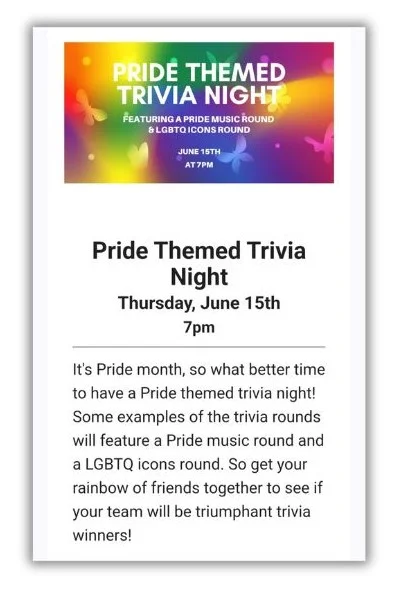

If you want to be an ally, find meaningful ways to lend your content platforms. These ideas will get you started:
- Make a watch list of LGBTQ movies, from comedies to documentaries.
- Host an event on Instagram Live, like a trivia contest or speaker series.
- Share stories of important LGBTQ figures that shaped the culture and movement.
- Organize a Pride parade watch party.
D-Day (June 6)
On D-Day, we remember the thousands of brave soldiers, sailors, airmen, and marines who participated in the Invasion of Normandy during World War II—the largest amphibious invasion in history.
Plumbers “R” Us does an excellent job of using its Instagram page to remind its followers of the aftermath of D-Day.


Here are a handful of ideas you can use to keep the memory of this day alive:
- Share images from the fateful day and a few brief words explaining what it means to you.
- Suggest a moment of silence at a particular time on June 6.
- Create a slideshow or Instagram Story highlighting a few inspirational figures from that day.
- Publish a blog post about World War II war memorials or museums in your area that people can visit.
More June awareness content ideas
June offers a lot to be thankful for and mindful of. These additional content ideas are a great way to share this with your followers and customers.
- National Adapt-a-Cat Month
- National Foster a Pet Month
- National Say Something Nice Day (June 1)
- International Corgi Day (June 4)
- National Hug Your Cat Day (June 4)
- International Yoga Day (June 21)
- National Take Your Dog to Work Day (June 21)
- National Yard Games Day (June 21)
- World Day of Music (June 21)
- Global Beatles Day (June 25)
- Alzheimer’s and Brain Awareness Month
- National Play Outside Day (June 1)
- National Go Barefoot Day (June 1)
- World Pet Memorial Day (June 11)
- National Random Acts of Light Day (June 13)
- US Army Birthday (June 14)
- World Blood Donor Day (June 14)
- Global Garbage Man Day (June 17)
- World Rainforest Day (June 22)
- World Refugee Day (June 30)
- National Day of Indigenous People (June 21)
- Family Owned & Operated Business Day (June 23)
- Helen Keller Day (June 27)
Summer fun June content ideas
Summer takes off in June, so there are plenty of sun-fueled topics to discuss online. Travel, beach days, pool parties, and outdoor activities are all on the table. These creative June content ideas will let you tap into those hot summer vibes.
Ask a summer-related question
Engagement is key to success in digital marketing. You don’t just want to talk at your audience; you want them to participate in the conversation. One surefire way to do it is to ask questions.
Here’s a simple option to start the conversation. Post a question in an image that people can answer in the comments.
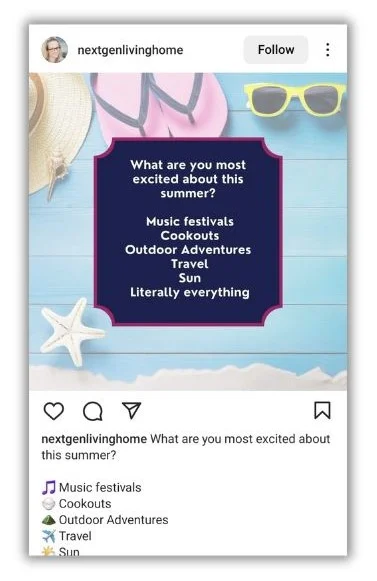

Polls on Instagram and other platforms can also work. You can even ask for feedback through email and ask if it’s okay to share it on other channels. The opportunities are endless, so consider this list of questions as inspiration for your next June campaign:
- Beach or mountains for the summer?
- Favorite summer food?
- Favorite beach?
- What song makes you think of summer?
- Best summer vacation?
- Favorite summer activity: fishing, outdoor concerts, grilling, hiking?
- Most recent summer read?
Gather summer-themed UGC
User-generated content is the not-so-secret weapon of the best online marketers. Why is it so great? Because it’s a fast way to fuel your online content from real people who use your product. It’s a triple win!
UGC is great for June content because people are excited to share their images of early summer. To boost your June UGC campaign, tie it to a free giveaway or contest, like Hydroflask did.
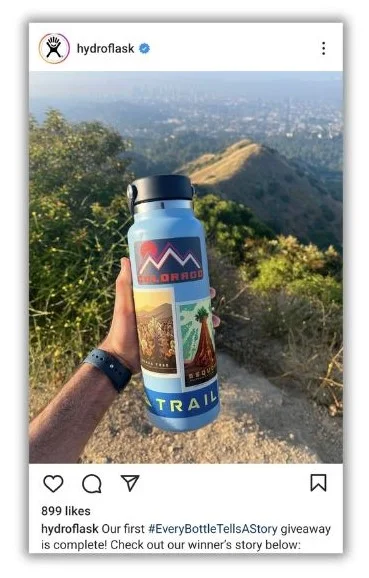

Ask your fans and followers to enter the contest by following your account, liking or commenting on the post, or clicking a link to a contest landing page. Notice how Hydroflask also used a unique hashtag. That’s a fantastic tactic to make it easy for people to share your campaign in their networks.
You can run a UGC campaign at any time, but here are a few days in June that would be ideal for it:
- National Selfie Day (June 21)
- National Camera Day (June 29)
- Social Media Day (June 30)
Create summer to-do lists
People start making summer plans as soon as the temperature starts climbing. It’s easy to feel like you’ve left something important off the list. Help your audience by creating a themed summer to-do list and distributing it as part of your June content calendar.
YouTuber Becca Bradley posted this summer bucket list on YouTube, which gave her followers many ideas for spending their summer days.
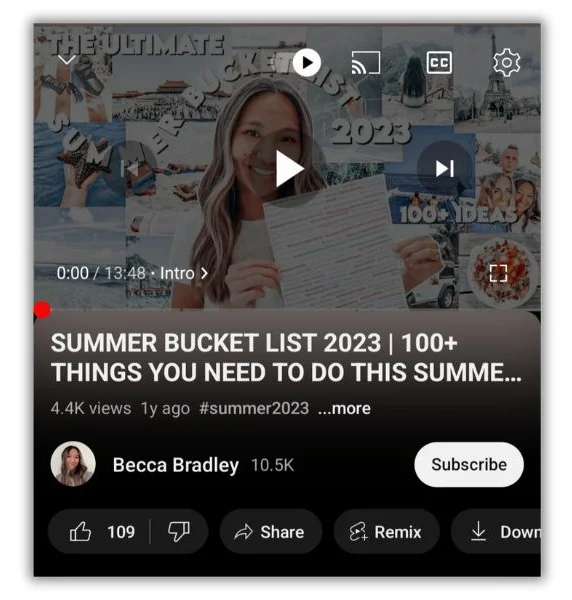

What’s great about this June content idea is that you don’t need expensive recording equipment or editing apps. Just make a list of summer activities and explain them. You can even add a theme, like activities with your pet or activities for kids.
Give your summer to-do lists a little more focus by tying them to fun observance days. Here are some ideas:
- Conservation efforts for National Pollinator’s Month, World Environment Day (June 5), or World Ocean Day (June 8)
- Kid-friendly activities for National Zoo and Aquarium Month, National Drive-In Movie Day (June 6), or World Picnic Day (June 18)
- Outdoor activities for Great Outdoors Month, National Parks Trail Day (June 1), or National Go Fishing Day (June 18)
- Summer sports to try for World Bicycle Day (June 3), World Softball Day (June 14), or National Tennis Week (June 23 to 29)
June content ideas to keep the summer vibes rolling
Your June content will be a valuable marketing tool whether you’re after awareness, looking for leads, or counting on conversions. The keys to success are to be authentic and creative so your audience has a reason to look forward to the next post, email, or video.
While you mull over the content that will fill your June calendar, get even more inspiration from these June marketing guides:
-

 MARKETING3 days ago
MARKETING3 days ago18 Events and Conferences for Black Entrepreneurs in 2024
-

 MARKETING5 days ago
MARKETING5 days agoAdvertising on Hulu: Ad Formats, Examples & Tips
-

 WORDPRESS6 days ago
WORDPRESS6 days agoBest WordPress Plugins of All Time: Updated List for 2024
-

 MARKETING6 days ago
MARKETING6 days agoUpdates to data build service for better developer experiences
-

 WORDPRESS6 days ago
WORDPRESS6 days agoShopify Could Be Undervalued Based On A Long-Term Horizon
-

 PPC6 days ago
PPC6 days agoLow Risk, High Reward YouTube Ads alexking
-

 WORDPRESS4 days ago
WORDPRESS4 days ago5 Must See Telegram Plugins for WooCommerce
-

 MARKETING3 days ago
MARKETING3 days agoIAB Podcast Upfront highlights rebounding audiences and increased innovation


